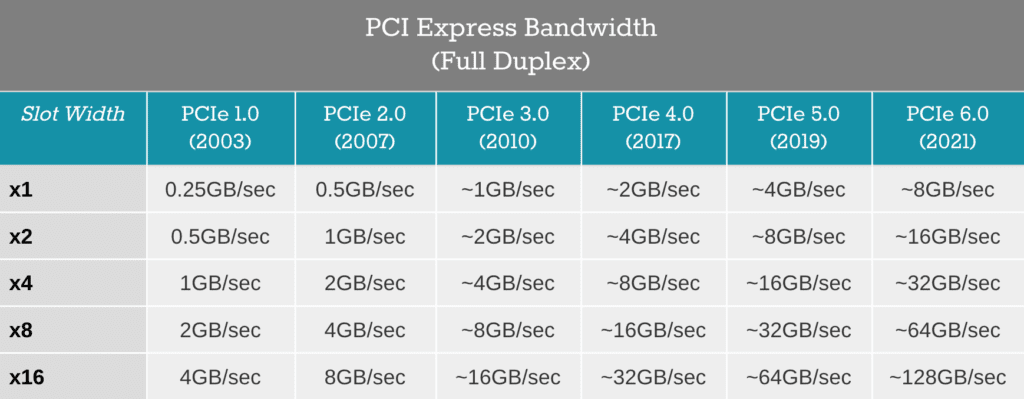

Moving from PCIe Gen 2 to Gen 3 doubles the bandwidth available to the add-on cards installed, from 500 MB/s per lane to 1 GB/s per lane. It is the best performing and functional PCIE Slot for today's PCI Express cards such as graphics cards. PCI Express Gen 3 actually has twice the available bandwidth, 32 GB/s per lane (bi-directional), but also some efficiency and compatibility. Simply put, PCI Express Gen 3 provides a 2X faster transfer rate (bandwidth) over the previous 2.0 generation, this delivers capabilities for next generation gaming graphics cards. The all new PCI Express Gen 3 is really fantastic, but what does that mean to you as an end user ? With PCIe Gen 3.0, processors and compatible platforms (mobo and VGA) can feature 16 PCIe 3.0 lanes to be used for graphics and/or other add-in PCI cards. If you need a new computer it’s best not to worry about waiting for some potential latest and greatest at an unspecified date.Tweet The Differences in Generational PCIe slots
#Pci e bandwidth Pc
But don’t let the looming PCIe 6.0 transition stand in your way of getting a new PC or laptop.

Whether that’s what Intel, AMD, and computer makers have planned is anybody’s guess. With PCIe 4.0 and 5.0 already crowding each other, it makes more sense to skip this mess and get to PCIe 6.0 as soon as possible. Given the advantages, we’d hope to see a transition to PCIe 6.0 happen fairly quickly assuming the technical hurdles don’t cause serious delays. Since PCIe 6.0 graphics cards aren’t likely to require those bigger x16 connections that might translate into lower hardware costs for PC shoppers while maintaining the maximum bandwidth of current graphics cards.

Even so, as AnandTech points out, a transition to PCIe 6.0 could mean lower prices. How soon gamers or video editors will need PCIe 6.0 is unclear. So what happens next? Who knows? When the PCIe 4.0 transition started, graphics cards–the most resource-intensive PCIe devices on consumer PCs–weren’t even saturating the maximum bandwidth of PCIe 3.0. On the graphics card side, AMD released its first PCIe 4.0 GPUs around the same time as its CPUs, while NVIDIA followed suit in 2020. AMD released the first PCIe 4.0-supporting CPUs for consumers in mid-2019, and Intel didn’t do it until early 2021. Right now, we’re just barely into the PCIe 4.0 era for home PCs.
#Pci e bandwidth how to
That’s where the PCI-SIG expects to see PCIe 6.0 arrive first after hardware makers figure out how to turn the specification into actual products.Īs for the consumer market, this could take a while as it’s up to the CPU makers (AMD and Intel) and their manufacturing partners to figure out when to release gear supporting PCIe 6.0. This includes the auto and aerospace industries, data centers, and so on. More likely we’re looking at mid- to late-2023 for early examples of PCIe 6.0, which in all likelihood won’t be aimed at consumers.Īll that bandwidth promised by PCIe 6.0 is really needed in areas that rely on machine learning and artificial intelligence. PCIe 6.0 was announced on January 11, 2022, so at the earliest, we’re looking at PCIe 6.0 products rolling out at the end of 2022 or early 2023. The PCI-SIG estimates that we won’t see PCIe 6.0 gear hit the market until 12 to 18 months from the publication of the new standard. But when, exactly, will you get to experience this speedier standard at home? When Will We See PCIe 6.0? PCI-SIG The most noticeable improvement we’re likely to see in the early days is with NVMe SSD speeds just as we saw with the transition to PCIe 4.0–SSDs typically use 4 PCIe lanes.

That’s an insane upgrade, but current games wouldn’t come close to saturating that much bandwidth. So PCIe 6.0 has eight times greater bandwidth than a predecessor that is still being widely used. PCIe 3.0 maxes out at 32GB/s cumulative on an x16 slot. Now let’s compare that to PCIe 3.0, which was the standard for years and is still largely used at home unless you’ve built or bought a new PC since 2019 or 2020 (and paid a premium for it). In the case of PCIe 6.0 this means 128GB/s each way for a total of 256GB/s. That bi-directional bandwidth number indicates the total amount of data the card could send to the CPU and that the CPU could send back to the card. To understand what this means, imagine if you had a graphics card in a PCIe 6.0 slot. PCIe 6.0 x16 slots have a maximum bi-directional bandwidth capability of 256 gigabytes per second (GB/s), compared to 128GB/s with PCIe 5.0.


 0 kommentar(er)
0 kommentar(er)
